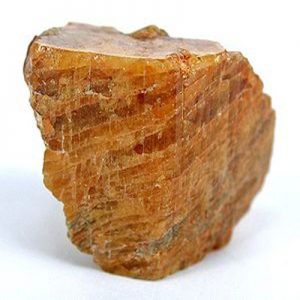Simpsonite
Simpsonite is an extremely rare gem that is very attractive in the bright yellow to yellow-orange colors. It is found in a few locations worldwide but only available in facetable crystals from Onça and Paraiba, Brazil and Tabba Tabba, Western Australia. Gems are usually very small since crystals are small and clean material is a very small percentage of the limited supply of Simsonite that has been found. Most crystals are completely opaque. It is a very durable gem with hardness of 7.5 and no cleavage. It would make a very attractive gem for jewelry if it was more abundant and available in larger sizes.
Simpsonite may exhibit fluorescence under shortwave UV light. The color of the fluorescence depends on the origin of the gem; bright blue-white (Western Australia), bright pale yellow (Bikita, Zimbabwe), medium pale yellow (Ecuador), light blue (Paraiba, Brazil). If you place your cursor over the picture above, you will see the light blue fluorescence of a Simpsonite gem from Paraiba, Brazil. Simpsonite may also exhibit blue-white cathodoluminescence.
Simpsonite was named in 1938 by Harry Bowley (1882-1958) in honor of Edward Sydney Simpson (1875-1939), government mineralogist and chemist of the Geological Survey of Western Australia. The Simpson Desert in Northern Territory, South Australia and Queensland in central Australia was also named for him. In 1897 he became mineralogist and assayer with the Geological Survey of Western Australia. He helped to establish the Western Australian School of Mines. Simpson was a founder of the Natural History and Science Society of Western Australia and its successor, the Royal Society of Western Australia which awarded him the Kelvin Medal in 1929. He was awarded the Clarke Medal by the Royal Society of New South Wales in 1934. Simpson published A Key to Mineral Groups, Species and Varieties in 1932 and a three-volume set Minerals of Western Australia was published after his death in 1939. Harry Bowley was appointed to succeed Simpson as Government Analyst in 1939. Bowley joined the Western Australian Geological Survey Laboratories in 1897, rising to become Director of the Western Australian Government Chemical Laboratories in 1946.
Simpsonite distribution: from Tabba Tabba, Western Australia. At the Alto do Giz pegmatite, near Parelhas, and the Onça mine, about 25 km distant, Rio Grande do Norte, Brazil. In the Al Hayat and Mdara mines, Bikita, and at the Benson No. 3 pegmatite, Mtoko, Zimbabwe. In Congo (Zaire), from Mumba, near Lake Kivu, Kivu Province, and in the Manono pegmatite, Katanga (Shaba) Province. At the Leshaia pegmatite, Vuoriyarvi carbonatite complex, Kola Peninsula, Russia. In Canada, from the Tanco pegmatite, Bernic Lake, Manitoba.
| Chemical Formula: | Al4(Ta,Nb)3O13(OH) |
| Aluminum Tantalum Niobium Oxide Hydroxide | |
| Molecular Weight: | 813.65 gm |
| Composition: | Tantalum | 53.37 % | Ta | 65.17 % | Ta2O5 |
| Niobium | 5.71 % | Nb | 8.17 % | Nb2O5 | |
| Aluminum | 13.26 % | Al | 25.06 % | Al2O3 | |
| Hydrogen | 0.12 % | H | 1.11 % | H2O | |
| Oxygen | 27.53 % | O | |||
| 100.00 % | 99.51 % | = TOTAL OXIDE |
| Crystallography: | Trigonal – Pyramidal |
| Crystal Habit: | Euhedral to subhedral crystals, tabular to short prismatic, with {1010} and {0001}, and rarely a few other forms, striated || [0001], to 2.4 cm; commonly in subparallel groups. |
| Twinning: | None |
| Cleavage: | None observed |
| Fracture: | Conchoidal |
| Tenacity: | Brittle |
| Moh’s Hardness: | 7.0 – 7.5 |
| Density: | 6.68 -6.82 (g/cm3) |
| Luminescence: | Blue-white cathodoluminescence. May be fluorescent in SW UV; bright blue-white (Western Australia), bright pale yellow (Bikita, Zimbabwe), medium pale yellow (Ecuador), light blue (Paraiba, Brazil) |
| Radioactivity: | Not Radioactive |
| Color: | Yellow, light brown, colorless, gray, yellow-brown when altered; colorless in transmitted light |
| Transparency: | Semitransparent, translucent |
| Luster: | Adamantine, vitreous, dull |
| Refractive Index: | 2.045 – 2.025 Uniaxial ( – ) |
| Birefringence: | 0.020 |
| Dispersion: | None |
| Pleochroism: | FNone |


